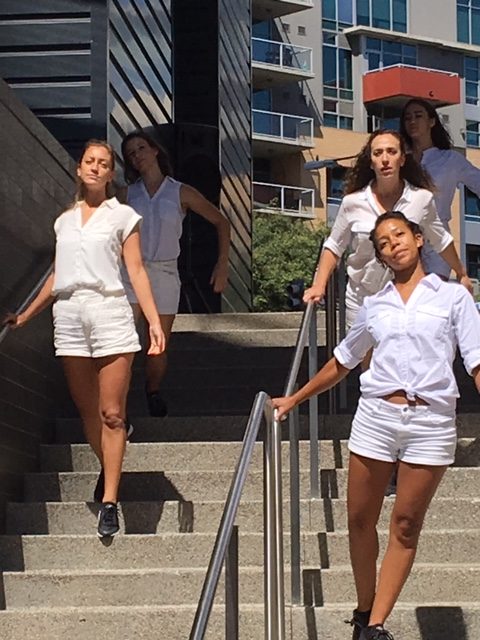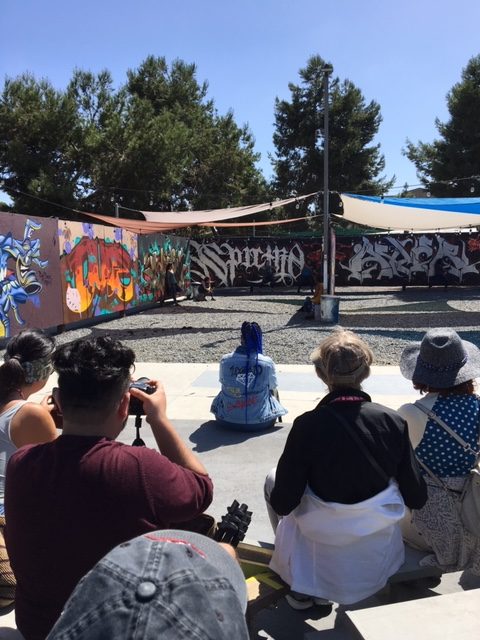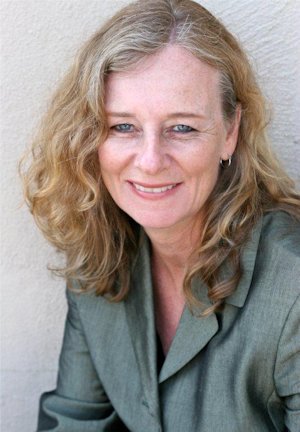‘Trolley Dances 2019’ Brings Brilliant Site Specific Work that Lingers
Free from the confines of a concert stage, Trolley Dances brings dance to unexpected places: swimming pools and grocery aisles, parking lots and historic parks, even the Mexican border fence.
In its 21st year, the adventure created by San Diego’s pioneering choreographer Jean Isaacs is a community tradition, but it didn’t start out that way.
“I couldn’t afford a theater and wanted to pay my dancers,” Isaacs says. “I was in Switzerland and we rode a little white bus to view fascinating dance in peculiar places. Site-specific dance was an alternative. I partnered with the San Diego Metropolitan Transit System, and now we go to different communities every year.”
This year the tour begins at 12th and Imperial and follows the Orange Line to Euclid Ave., and back to the Federal Courthouse.
Nearly 100 dancers auditioned in July, and Isaacs’ San Diego Dance Theater hired about 50 dancers.
Six choreographers selected dancers to perform along the trolley line for two weekends, Sept. 27 and 28, and Oct. 5 and 6. They’ll dance five times daily along an expanding light-rail system.
The choreographers include: Jeremy Zapanta, Kevin Jenkins, Anjanette Maraya-Ramey, Lara Segura, Angel Acuna, and Regula Mahler. Each choreographer is inspired by the architecture, landscape, history, or politics of their selected site.
Led by tour guides with red flags, we walk to a courtyard to view dancers obscured by trees. The sound of a violin score beckons us to walk through Zapanta’s “Out of Sorts” at Park 12-The Collection. As the wind blows, dancers dressed in green and black mirror bending branches and fluttering leaves. They scoop their arms and lean, suggesting they are stewards of the trees. Or perhaps they are trees, as they ignore a man walking through the middle of their dance and a blaring car alarm.

“Out of Sorts” by choreographer Jeremy Zapanta. Image: Kris Eitland
We continue to walk by a swirly metal sculpture that looks like a giant soft-serve ice cream, and we admire oval sculptures akin to giant baked beans.

“Memory Lane” by choreographer Kevin Jenkins.
Around the corner, we spy women dressed in white shorts on a concrete stairway. It’s as if we’ve crashed someone’s casual, yet royal wedding. The women walk and weave with reverence in formation, up and down the stairway in homage to a man and woman at the top. The couple represents true love and performs fluid, balletic extensions and lifts on the stairs, accented by syncopated heel-pops. There’s a sense of danger.
Normal humans may experience a vertigo attack by watching. With each arabesque, viewers gasp. As the sound of Bach wafts through, we are swept up in a royal event and forget we are downtown. The work is enthralling, and we wave goodbye with queenly hands as the couple and attendants ascend the stairs and disappear.
For dance three, the tour boards the trolley at 12th and Imperial on the Orange Line toward El Cajon. On a Sunday tour, the group assisted two people using wheelchairs. Friends chatted and read their programs. A mother sang to her children as we passed a mobile home park. Another woman was still talking on her cell phone when we stopped at the Jacob Center and walked on Market Street.
Choreographer Maraya-Ramey greeted us in front of Writerz Blok/Arts Park, an innovative arts program designed to prevent vandalism. To navigate her immersive work “Towards Belonging,” we follow yellow caution tape.

“Towards Belonging” by choreographer Anjanette Maraya-Ramey.
Spoken word artist Dairrick Khalil Hodges speaks eloquently and sings about a love letter, and Emerald Hills, (once a burial site for the Kumeyaay Indian tribe and a golf course) and now “a Diamond neighborhood.” “Welcome to south east…the belly of the beast” he shouts, as a chain link fence swings open. Surrounded by panels of brilliant graffiti art, dancers spin and grind their feet into gravel with gritty fearlessness. Their shiny skin embodies the beautiful and diverse colors of Americans.
As we leave the school, Writerz Blok founder Jose recalls,“I was once a problem, but now artists come here from all over the world, and we work with high schools and detention groups.” He says the panels are sprayed over every few days. The art displays we view will soon be gone. Check out www.writerzblok.com
A short walk away, we find Arts Park at Chollas Creek, on land of the Kumeyaay People. Segura honors their stewardship in “Visualizing Biodiversity,” a calming dance experience that heightens all of the senses. We hear voices pointing out dragon flies and cactus, and feet crunching the decomposed granite trail. Fragrant native plants mix with a warm breeze as couples balance on a wall and stir the ground with skips and grapevine footwork. As the dancers move faster, our breathing slows as we take in the natural space preserved in a city.
Trolley Dances is an adventure and dance discovery, especially for those who have never ridden the trolley. Experienced trolley riders are eager to people help disabled people operate the wheelchair ramps. People of all ages are busy going to school and work, and hanging on.
Site specific dance has lasting impact. Strange neighborhoods no longer seem foreign when a mother and baby wave. We will find ourselves visualizing dances in unusual places, even years later.
The tour ends with a trolley ride west for two dances at the Federal Courthouse Courtyard where artistic symbols and metaphors have no limits.
Angel Acuña’s “Collective W8” takes advantage of the expansive space surrounded by government buildings to explore the innocence and resilience of children.
Acuña appears as a protective mother or spirit watching over a group of young Latina girls. The courtyard is a playground and as they run, they become super heros. Scarves sewn onto their clothes are imaginary wings. The work finds resolution when the girls blow bubbles and play telephone with plastic cups and a string. The finale has an alpha woman in foil recite poetry, and there is more elation when the girls grip hands and circle to Madonna’s “Ray of Light.” The refrain echoes off buildings. “And I feel like I just got home, and I feel like I just got home…” which is an injection of joy and power.
When Isaacs talks about Trolley Dances, she’s quick to credit the little white bus she rode decades ago, and the Swiss choreographer Regula Mahler.

“Currents” by choreographer Regula Mahler.
For the 21st edition, Mahler is here as the final dance maker, and seeing her inspired piece is worth every step and climb on the tour nearing three hours.
Her work “Currents” is brilliant and beautiful–everything site-specific work should be.
Mahler takes advantage of angles and hiding places, shadows and bright light. The work is highly strategic. The score is exhilarating from the start with techno-beats. Dancers dressed in flowered prints are barely visible at the end of a narrow ramp. They rise like sneaky sprouts in a garden, and they roll over each other to grow larger.
Like vines in springtime, they climb and coil on concrete walls. They mimic the angles, and images of hands gripping vertical edges are striking. Dancers are expressive and tough. They don’t hesitate to roll on the concrete and pose on a shoulder with feet in the air. Even as they shrink back into the shadowy cavern, their energy is unwavering.
Mahler has designed every move and sight line. If you grab a cushion on the ground, you’ll make direct eye contact and an electric connection that could charge your phone.
Trolley Dances continues Oct. 5 and 6. http://www.sandiegodancetheater.org/trolleydances.html
As part of the event, Isaacs started Kids-on-Board, an outreach program that brings 700 students and teachers to Trolley Dances for free. “It’s a field trip they won’t forget.” The popularity of Trolley Dances also inspired tours in San Francisco, run by Kim Epifano. http://epiphanydance.org/san-francisco-trolley-dances/

Kris Eitland covers dance and theater for Sandiegostory.com and freelances for other publications, including the Union Tribune and Dance Teacher Magazine. She grew up performing many dance styles and continued intensive modern dance and choreography at the Univ. of Minnesota, Duluth, and San Diego State Univ. She also holds a journalism degree from SDSU. Her career includes stints in commercial and public radio news production.
Eitland has won numerous Excellence in Journalism awards for criticism and reporting from the San Diego Press Club. She has served on the Press Club board since 2011 and is a past president. She is a co-founder of Sandiegostory.com. She has a passion for the arts, throwing parties with dancing and singing, and cruising the Pacific in her family’s vintage trawler. She trains dogs, skis, and loves seasonal trips to her home state of Minnesota.

Nice article! Thanks for reminding me…haven’t seen them for a couple years, but I’ll make time this weekend.